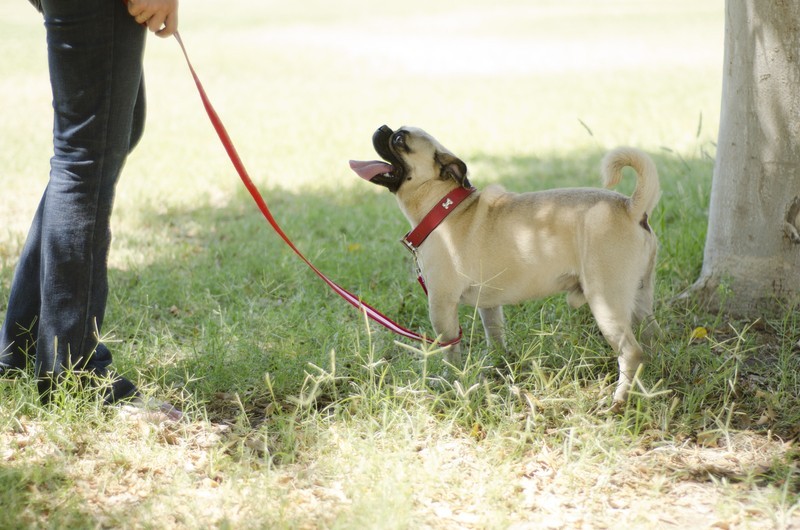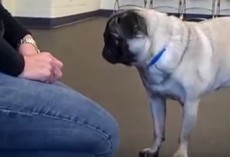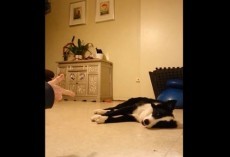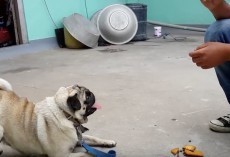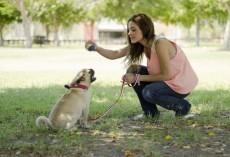One technique to try is to start the walk out calmly from the getgo. This means not taking him on a walk until he calms down first. Learning techniques like this will go a long way and hopefully lead you to have a pleasant walk.
Dogs have to be taught to walk nicely on leash. They’re not born knowing that they shouldn’t pull ahead or lag behind. Teaching leash manners can be challenging because dogs move faster than us and are excited about exploring outdoors. To teach your dog to walk without pulling, it’s critical that you never allow him to pull.
How to Teach Your Dog to Walk Nicely on a Leash
You can use various methods to teach dogs to walk without pulling on leash. No single method works for all dogs. Here are some overall guidelines before we look at several methods:
• Until your dog learns to walk without pulling, consider all walks training sessions. Keep training sessions frequent, short and fun for your dog.
• Since loose-leash training sessions will be too short and slow to provide adequate exercise, find other ways to exercise your dog until he’s mastered loose-leash walking.
• Teaching a dog to walk without pulling requires plenty of rewards. Use highly desirable treats that your dog doesn’t get at other times. Soft treats are best so your dog can eat them quickly and continue training.
• Walk at a quick pace. If your dog trots or runs, she’ll have fewer opportunities to catch a whiff of something enticing, and she’ll be less inclined to stop and eliminate every few steps.
• If you expect your dog to control herself while walking on leash, you must also expect her to control herself before you go for a walk. If she gets wildly excited as you prepare for a walk, you need to focus on that first. Walk to the door and pick up the leash. If your dog races around, barks, whines, spins or jumps up, just stand completely still. Do and say absolutely nothing until your dog calms down a bit. Repeat this sequence until your dog can stand in front of you, without jumping up or running around, while you clip on her leash. This may seem like a tedious exercise at first, but if you’re consistent, your hard work will pay off.Option One: Red Light, Green Light
(This method requires that your dog already have a reliable Sit and Come in distracting places.)
Walk in your intended direction. The instant your dog reaches the end of his leash and pulls, red light! — stop dead in your tracks and wait. When he stops pulling and puts slack in the leash (maybe he turns to see what you’re doing and this makes the leash a little slack), call him back to you. When he comes to you, ask him to sit. When he does, say “Yes,” give him a treat and resume walking (green light). If your dog looks up at you in anticipation of more tasty treats, quickly say “Yes,” and give him one while you keep walking. If he pulls again, repeat the red-light step above. As you’re walking, reward your dog frequently for staying next to you or slightly ahead and for looking up at you. If you do this consistently, he’ll learn that 1) if he stays near you or looks at you, he gets treats and gets to keep moving, and 2) if he pulls on the leash, the fun stops because he doesn’t get to keep walking and he has to come back to you and sit.
Option Two: Lure and Reward
Start with your dog standing at your left side. With several treats enclosed in your left hand, hold your left hand right in front of your dog’s nose (within 1 inch of it). Say “Let’s walk,” and walk in your intended direction. Every few seconds, pop a small treat into your dog’s mouth and praise her for walking along at your pace. You’ll need to frequently reload your hand with treats from your left pocket or from a treat pouch attached to your waist. If she pulls ahead or to the side, immediately stop. Get your dog’s attention by calling her name again. Ask her to sit, and praise her when she does. Then put the treat-loaded hand back in front of her nose and start walking again. Go a little bit farther every day that you practice. Eventually, you should be able to walk with your hand comfortably at your side, periodically (every minute or so) reaching into your pocket to grab a treat to reward your dog.
Choosing the Right Walking Equipment
While you’re teaching your dog not to pull, you should use a four-foot or six-foot leash. Use whichever width and material that feel comfortable to you. Extendable leashes, such as the Flexiä, or leashes longer than six feet in length are great for exercising dogs, but they don’t work well if you’re trying to teach your dog not to pull on leash.
Head halters and no-pull harnesses can decrease pulling enough for you without any additional training. They are effective tools, making walks more pleasant for you and your dog, so some people decide not to train at all.
Unsuitable Choices
• Regular body harness (Actually encourages pulling)
• Fabric or metal choke/check collarDogs Who Resist Walking on Leash
Some dogs seem reluctant to walk on leash. Instead of pulling, they freeze or turn around and pull back toward home. Often these dogs are fearful, and they need help feeling comfortable when walking on leash.
• Try leading your dog along by holding tasty treats in front of his nose. If he isn’t too afraid, he’ll follow the treats and gradually become more comfortable walking with you.
• When your dog freezes, you can also try stopping a few feet in front of your dog and waiting. If he shows any signs of moving toward you, say “Yes!” and reach toward him to deliver a treat. Praise and reward him only for forward movement.
A third technique is appropriate only for small- to medium-sized dogs who walk for stretches at a time but then balk for no apparent reason. Have your dog wear a regular body harness. When he stops walking, pick him up by the back of the harness and move him a few feet along. This may “jump start” your dog to move again. Say “Yes!” and treat when the dog begins to move again on his own.
Final Tips
• If you’d like help teaching your dog to walk politely on leash—or if you’d like to learn how to train additional useful skills—consider contacting a Certified Professional Dog Trainer (CPDT) in your area.
As the article above from ASPCA mentions, a big part of teaching your dog to walk at the right pace without tugging is to make sure he is wearing the correct harness and leash.
We'd also like to mention that you should not use a retractable leash as it can be hard for you to control it. Furthermore, your dog may break the retractable leash if he is strong enough or moves forward suddenly. A fabric leash is the best option since it is sturdy and will help you teach your pup a more easily.
